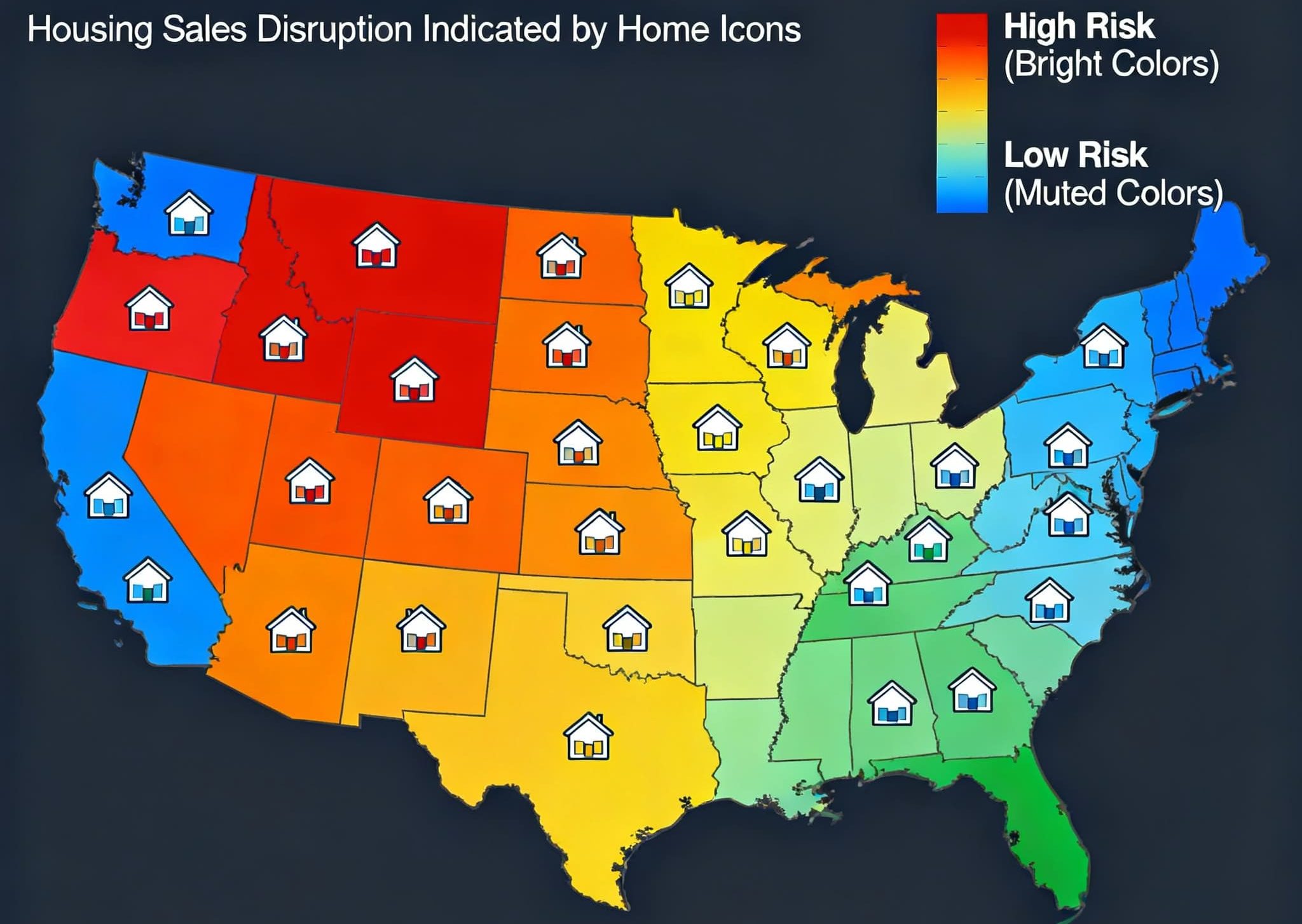Editorial Integrity
Making informed real estate decisions starts with having the right knowledge. At HomeAbroad, we offer US mortgage products for foreign nationals & investors and have a network of 500+ expert HomeAbroad real estate agents to provide the expertise you need. Our content is written by licensed mortgage experts and seasoned real estate agents who share insights from their experience, helping thousands like you. Our strict editorial process ensures you receive reliable and accurate information.
U.S. residential building permits in the top-100 metros reveal a pronounced shift toward single-family construction amid widespread multifamily declines from 2020 to 2025. Analysis of July month permit data shows that while 61 metros recorded fewer total units permitted in 2025 versus 2020, the decline was driven primarily by 5+ unit projects.
Multifamily permits fell in 46 metros with a median drop of 71%, while single-family activity increased in only 31 metros but with substantial gains averaging 40% where growth occurred. Building permits serve as a widely used leading indicator of future housing supply and comprise a key component of the Conference Board’s Leading Economic Index.
Table of Contents
Key Highlights
10+ U.S. Home Building Permits Statistics [2025]
1. 61 metros recorded total permit declines, with median drop of 32.3%.
The breadth of total permit declines reflects the outsized impact of multifamily construction reductions in most major metros. Nearly two-thirds of the top U.S. metropolitan areas saw permit volumes decline from 2020 to 2025, signaling widespread retreat from the construction boom of earlier years.
The median decline among these 61 metros was a steep 32.3%, highlighting the depth and breadth of the slowdown. Markets hit hardest ranged from tech hubs to Rust Belt cities, reflecting broad market headwinds. The remaining 38 metros that achieved permit growth were geographically concentrated and often reflected specific local market dynamics.
Top 10 Metros by Highest Home Building Permit Declines (Total Units)
| Rank | Metro | 2020 | 2025 | Decline | % Decline |
|---|---|---|---|---|---|
| 1 | San Jose-Sunnyvale-Santa Clara, CA | 1949 | 623 | -1326 | -68% |
| 2 | Kansas City, MO-KS | 2014 | 701 | -1313 | -65% |
| 3 | Austin-Round Rock, TX | 3979 | 2917 | -1062 | -27% |
| 4 | Nashville-Davidson-Murfreesboro-Franklin, TN | 3144 | 2099 | -1045 | -33% |
| 5 | Los Angeles-Long Beach-Anaheim, CA | 2715 | 1694 | -1021 | -38% |
| 6 | Phoenix-Mesa-Scottsdale, AZ | 4659 | 3656 | -1003 | -22% |
| 7 | Houston-The Woodlands-Sugar Land, TX | 6663 | 5771 | -892 | -13% |
| 8 | Seattle-Tacoma-Bellevue, WA | 1798 | 1008 | -790 | -44% |
| 9 | New York-Newark-Jersey City, NY-NJ-PA | 4738 | 3965 | -773 | -16% |
| 10 | Minneapolis-St. Paul-Bloomington, MN-WI | 1988 | 1241 | -747 | -38% |
2. Single-family permits increased in only 31 metros, median increase among risers 39.8%.
While multifamily fell significantly, only a minority of metros managed to increase single-family permitting. Gains were concentrated in smaller or secondary markets, where local demographics favored detached housing or where budget buyers sought alternatives to multi-unit properties. The median riser’s near 40% growth reveals isolated pockets of opportunity amid national uncertainty.
3. 46 metros saw dramatic multifamily (5+ units) permit declines, median drop 71.8%.
The decline in multifamily permits was both widespread and severe, affecting nearly half of the nation’s largest metropolitan areas. Among the 46 metros experiencing 5+ unit permit declines, the median drop reached 71.8%, indicating substantial reduction in the multifamily construction pipeline. High-growth markets that had experienced construction booms saw particularly steep reversals, while only a limited number of metros maintained or increased multifamily permit activity.
4. Single-family homes share declined by 6.3% (2020–2025).
The typical metro’s 1-unit (single-family) share of total permits dropped from 79.0% in 2020 to 72.7% in 2025; a decrease of 6.3 percentage points. This change occurred because multifamily construction, though it contracted sharply, did not contract as quickly as single-family in many regions. Thus, single-family’s share of all new permits declined slightly rather than increasing.
5. Average units per multifamily building increased modestly from 18.4 to 21.7 units.
Despite dramatic changes in permit volumes, the typical size of permitted multifamily projects grew slightly. The median metro saw the ratio of 5+ unit permits per building climb from 18.4 in 2020 to 21.7 in 2025, indicating that project scale increased somewhat as the number of multifamily structures permitted fell.
6. Zero multifamily permits affected 16 metros in 2025 versus 15 in 2020.
These zero readings, common in smaller or less urban metros, reflect persistent challenges or structural limits to apartment development rather than short-term trends. This cluster includes cities like Jacksonville, McAllen, Modesto, and Scranton in 2020, with Fresno, Albuquerque, and others joining in 2025.
7. San Jose-Sunnyvale-Santa Clara, CA had largest absolute permit decline of 1,326 units.
Permits fell dramatically from 1,949 to 623 total units. Highest multifamily declines (-1,248 units) among top 100 metros dwarfed single-family losses (-71 units). This sharp fall reflects the cooling of intense prior growth fueled by tech sector dynamics and affordability concerns.
8. New Orleans-Metairie, LA had the steepest percentage permit decline (-68.4%).
Total permits slid from 376 to 119 units. Both single-family (-235) and multifamily (-26) projects declined sharply, illustrating a severe contraction in an otherwise smaller market. Among the top 100 U.S. metros, New Orleans–Metairie, LA saw the steepest single-family permit decline (-75%).
9. Phoenix, AZ experienced the largest absolute single-family permit decline of 1,259 units.
Despite a total permit drop of 1,003 units, Phoenix stands out for its steep single-family losses, offset partially by a rise in large multifamily permits (+293).
10. San Antonio-New Braunfels, TX experienced the steepest multifamily percentage decline, -96.6%, losing 508 permits (2020: 526; 2025: 18).
Despite nearly static single-family permits (decreasing by only 7 units, 1,002 to 995), its multifamily collapse underscores specific multifamily market pressures in Texas.
11. Miami outpaced all metros with a total permit surge of 1,787 units (160%), with its multifamily permits ballooning by 1,866 units.
Miami-Fort Lauderdale-West Palm Beach posted the nation’s most rapid permit growth, powered by a multifamily surge that boosted permits from 445 to 2,311 units, and total permits from 1,117 to 2,904 units. The boom reflects strong population inflows and sustained apartment demand across South Florida, even as single-family permits fell 20% from 2020 levels.
Top 10 Metros by Highest Home Building Permit Increase (Total Units)
| Rank | Metro | 2020 | 2025 | Increase | % Increase |
|---|---|---|---|---|---|
| 1 | Miami-Fort Lauderdale-West Palm Beach, FL | 1117 | 2904 | 1787 | 160% |
| 2 | Dallas-Fort Worth-Arlington, TX | 4847 | 5800 | 953 | 20% |
| 3 | Raleigh, NC | 1257 | 1853 | 596 | 47% |
| 4 | Madison, WI | 485 | 1063 | 578 | 119% |
| 5 | Bridgeport-Stamford-Norwalk, CT | 193 | 698 | 505 | 262% |
| 6 | Columbus, OH | 1034 | 1452 | 418 | 40% |
| 7 | San Diego-Carlsbad, CA | 721 | 1135 | 414 | 57% |
| 8 | Omaha-Council Bluffs, NE-IA | 365 | 772 | 407 | 112% |
| 9 | North Port-Sarasota-Bradenton, FL | 645 | 1013 | 368 | 57% |
| 10 | Tampa-St. Petersburg-Clearwater, FL | 1428 | 1747 | 319 | 22% |
12. Hickory, NC posted a dramatic 5,200% increase in permits, reflecting volatile growth in smaller metros.
Single-family permits grew from 1 to 245 units, while multifamily permits rose from 5 to 65. This shows how smaller metros can experience dramatic swings, often reflecting fast-moving migration or market speculation.
13. Fresno demonstrated a 100% collapse in multifamily permits, going from 29 units to zero.
In Fresno, multifamily permits collapsed from 29 to zero, while single-family permits rose 26%, adding 69 units (2020: 265 vs. 2025: 334). The disappearance of multifamily activity underscores acute market or financial constraints, even as single-family construction showed modest growth.
Top 10 Metros by Highest Building Permit Declines (Single-family Homes)
| Rank | Metro | 2020 | 2025 | Decline | % Decline |
|---|---|---|---|---|---|
| 1 | Phoenix-Mesa-Scottsdale, AZ | 3003 | 1744 | -1259 | -42% |
| 2 | Houston-The Woodlands-Sugar Land, TX | 4952 | 4074 | -878 | -18% |
| 3 | Denver-Aurora-Lakewood, CO | 1232 | 574 | -658 | -53% |
| 4 | Atlanta-Sandy Springs-Roswell, GA | 2521 | 1959 | -562 | -22% |
| 5 | Austin-Round Rock, TX | 2077 | 1540 | -537 | -26% |
| 6 | Jacksonville, FL | 1312 | 841 | -471 | -36% |
| 7 | Dallas-Fort Worth-Arlington, TX | 3750 | 3294 | -456 | -12% |
| 8 | Riverside-San Bernardino-Ontario, CA | 1168 | 717 | -451 | -39% |
| 9 | Orlando-Kissimmee-Sanford, FL | 1480 | 1063 | -417 | -28% |
| 10 | Charlotte-Concord-Gastonia, NC-SC | 1787 | 1394 | -393 | -22% |
Top 10 Metros by Highest Building Permit Declines (5+ Units Multifamily Homes)
| Rank | Metro | 2020 | 2025 | Decline | % Decline |
|---|---|---|---|---|---|
| 1 | San Jose-Sunnyvale-Santa Clara, CA | 1697 | 449 | -1248 | -74% |
| 2 | Los Angeles-Long Beach-Anaheim, CA | 1728 | 556 | -1172 | -68% |
| 3 | Kansas City, MO-KS | 1311 | 204 | -1107 | -84% |
| 4 | Nashville-Davidson-Murfreesboro-Franklin, TN | 1815 | 872 | -943 | -52% |
| 5 | New York-Newark-Jersey City, NY-NJ-PA | 3555 | 2882 | -673 | -19% |
| 6 | Minneapolis-St. Paul-Bloomington, MN-WI | 989 | 389 | -600 | -61% |
| 7 | Austin-Round Rock, TX | 1868 | 1321 | -547 | -29% |
| 8 | San Francisco-Oakland-Hayward, CA | 602 | 67 | -535 | -89% |
| 9 | San Antonio-New Braunfels, TX | 526 | 18 | -508 | -97% |
| 10 | Seattle-Tacoma-Bellevue, WA | 762 | 287 | -475 | -62% |
U.S. Home Building Permits: Regional Statistics [2025]
The West: Steep declines dominated by tech metros and California markets
Western metros experienced the most severe permit contractions, with California leading absolute losses. San Jose-Sunnyvale-Santa Clara posted the steepest drop of 1,326 total permits (from 1,949 in 2020 to 623 in 2025), driven by a massive 1,248-unit decline in multifamily permits (1,697 to 449) and a smaller 71-unit drop in single-family permits (241 to 170). San Francisco-Oakland-Hayward followed with a 570-unit total decline (869 to 299), including an 88.9% multifamily collapse (602 to 67 units) and modest single-family losses (249 to 222). Los Angeles-Long Beach-Anaheim lost 1,021 total permits (2,715 to 1,694), with multifamily permits falling by 1,172 units (1,728 to 556) despite single-family gains of 176 units (815 to 991).
Seattle-Tacoma-Bellevue demonstrated broad-based weakness, losing 790 total permits (1,798 to 1,008), with multifamily permits dropping 475 units (762 to 287) and single-family permits declining 315 units (902 to 587). However, some Western metros showed divergent patterns: Las Vegas-Henderson-Paradise lost 537 total permits (1,384 to 847) but maintained modest multifamily growth of 2 units (36 to 38), while Denver-Aurora-Lakewood saw total permits fall 489 units (1,430 to 941) yet recorded strong multifamily growth of 182 units (181 to 363), offsetting single-family losses of 658 units (1,232 to 574).
The South: Sharp regional divergence between Florida growth and Texas/Carolina declines
Southern metros displayed the widest variance of any region. Florida metros emerged as clear winners: Miami-Fort Lauderdale-West Palm Beach surged by 1,787 total permits (1,117 to 2,904), powered by explosive multifamily growth of 1,866 units (445 to 2,311) despite single-family declines of 125 units (627 to 502). Tampa-St. Petersburg-Clearwater added 319 permits (1,428 to 1,747) with strong multifamily gains of 307 units (271 to 578) and minimal single-family losses of 15 units (1,155 to 1,140).
In contrast, major Texas metros faced significant setbacks. Austin-Round Rock lost 1,062 total permits (3,979 to 2,917), with balanced declines in multifamily (547 units, from 1,868 to 1,321) and single-family (537 units, from 2,077 to 1,540). Houston-The Woodlands-Sugar Land dropped 892 total permits (6,663 to 5,771), driven primarily by single-family losses of 878 units (4,952 to 4,074) and moderate multifamily declines of 260 units (1,669 to 1,409). However, Dallas-Fort Worth-Arlington bucked the Texas trend with 953 additional permits (4,847 to 5,800), featuring strong multifamily growth of 1,186 units (1,049 to 2,235) that more than offset single-family losses of 456 units (3,750 to 3,294).
Charlotte-Concord-Gastonia showed mixed dynamics with a 228-unit total decline (1,898 to 1,670), but contrasting trends within: single-family permits fell 393 units (1,787 to 1,394) while multifamily permits surged 157 units (108 to 265). Atlanta-Sandy Springs-Roswell recorded modest total growth of 137 permits (2,740 to 2,877), driven by substantial multifamily gains of 655 units (203 to 858) that overwhelmed single-family losses of 562 units (2,521 to 1,959).
The Midwest: Moderate declines with notable multifamily pipeline contractions
Midwestern metros experienced generally moderate but widespread declines. Kansas City, MO-KS led regional losses with 1,313 fewer permits (2,014 to 701), primarily from multifamily collapses of 1,107 units (1,311 to 204) alongside single-family drops of 114 units (595 to 481). Minneapolis-St. Paul-Bloomington lost 747 total permits (1,988 to 1,241), with multifamily permits falling 600 units (989 to 389) and single-family declining 128 units (967 to 839). Buffalo-Cheektowaga-Niagara Falls saw smaller absolute losses of 141 permits (234 to 93) but steep percentage declines, with multifamily permits dropping 103 units (123 to 20) and single-family falling 34 units (103 to 69).
However, several Midwest metros demonstrated resilience: Columbus, OH gained 418 permits (1,034 to 1,452) through strong multifamily growth of 500 units (513 to 1,013), offsetting single-family losses of 77 units (476 to 399). Omaha-Council Bluffs surged by 407 permits (365 to 772), with dramatic multifamily expansion of 282 units (5 to 287) and single-family growth of 115 units (358 to 473). Chicago-Naperville-Elgin posted moderate gains of 309 permits (1,542 to 1,851), balancing multifamily increases of 293 units (580 to 873) with single-family growth of 59 units (842 to 901).
The Northeast: Urban stability amid smaller metro weakness
Northeast metros showed relative stability in major urban centers but sharp declines in smaller markets. New York-Newark-Jersey City experienced a 773-unit decline (4,738 to 3,965) with multifamily permits falling 673 units (3,555 to 2,882) and single-family dropping 40 units (877 to 837). Boston-Cambridge-Newton lost 384 permits (1,305 to 921), with multifamily declining 198 units (773 to 575) and single-family falling 133 units (458 to 325). Philadelphia-Camden-Wilmington dropped 546 permits (1,483 to 937), driven by multifamily losses of 444 units (638 to 194) and single-family declines of 67 units (747 to 680).
Despite these contractions, the region’s largest metros maintained substantial multifamily activity levels, suggesting underlying demand resilience compared to more volatile smaller markets that often recorded zero multifamily permits in both years.
Methodology
Data Source: U.S. Census Bureau Building Permits Survey, accessed via monthly permit reports covering the Top-100 metropolitan statistical areas by population (Census Bureau).
This analysis examined U.S. Census Bureau Building Permits Survey data for the Top-100 metropolitan areas by population, comparing July month permit totals from 2020 to 2025 to identify construction trends across housing types. We calculated absolute and percentage changes for total permits and by unit type (single-family, duplex, small multifamily 3-4 units, and large multifamily 5+ units), then ranked metros by largest increases and decreases in each category. Regional patterns were identified by grouping metros into Census regions and highlighting representative examples. Quality checks confirmed all 100 metros were included with complete data, though we note this represents monthly snapshots rather than annual totals, and percentage changes can appear large in lower-volume markets. Building permits serve as a leading indicator of future construction activity, though actual construction timelines vary by local market conditions.
Download full building permit data for 100 U.S. metros here (2020-2025): Download CSV





![U.S. Home Construction Permits Declined 32% in Top 100 Metros [2025]](https://homeabroadinc.com/wp-content/uploads/2025/09/USHomeConstruction-500x325.jpg)




![Fed Rate Cut Could Save Homebuyers $20,565 [2025]](https://homeabroadinc.com/wp-content/uploads/2025/09/Fed-rate-cut-mortgage-savings-scaled.jpg)











